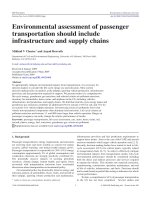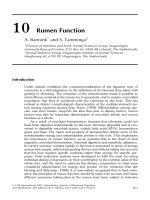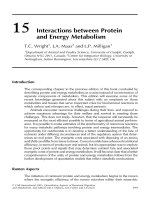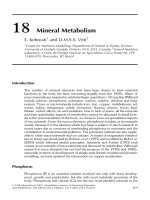Tài liệu PRODUCTION ANALYSIS OF HOUSEHOLD-LEVEL PAPER RECYCLING UNITS IN VIETNAM docx
Bạn đang xem bản rút gọn của tài liệu. Xem và tải ngay bản đầy đủ của tài liệu tại đây (7.79 MB, 155 trang )
PRODUCTION ANALYSIS OF HOUSEHOLD-LEVEL
PAPER RECYCLING UNITS IN VIETNAM
By
Ha Van Nguyen
A thesis submitted in conformity with the requirements for the degree of Doctor of
Philosophy, Faculty of Forestry, University of Toronto
© Copyright by Ha Van Nguyen (2005)
ii
ABSTRACT
PRODUCTION ANALYSIS OF HOUSEHOLD-LEVEL
PAPER RECYCLING UNITS IN VIETNAM
Doctor of Philosophy, 2005
Ha Van Nguyen
Faculty of Forestry, University of Toronto
Three essays that incorporate social, environmental and economic factors into
comprehensive production analyses of 63 paper-recycling units from Duong O craft
village, Bac Ninh province, Vietnam are presented in this dissertation.
The first essay developed a reduced-form model of the household production
function, in which social capital is treated as a production factor similar to other
conventional factors such as physical capital, labor, and human capital, and household
income and expenditure as dependent variables. The results show that social capital has a
strong and positive contribution to household income, and the positive contribution of
social capital on the general households’ income is greater than that of the paper-
recycling households. The results also indicate that trust and reciprocity play the most
important roles out of four components of social capital in contributing to household
income.
The second essay employed a parametric deterministic input distance function in
computing the relative shadow prices of social capital with respect to physical capital and
labor. The results indicate that social capital have positive effects on technical efficiency of
ii
iii
the paper recycling mills and impacts of one unit of social capital on technical efficiency is
much greater than that of one unit of physical capital, but less than that of one unit of labor.
The results also show that the role of social capital in production process is different for
different income groups and trust and number of memberships in associations play a key
role in increasing technical efficiency.
The third essay presents the use of a two-stage procedure which combines
deterministic linear programming with a stochastic parametric output distance function in
which both environmental effects and the role of social capital were considered and
encompassed within the production analysis. The results indicate that production
efficiencies could potentially be improved by 28% and there is a potential for improving
environmental quality through introducing pollution-prevention methods to paper-recycling
production processes in Vietnam. Furthermore, the study suggests that it may be
inappropriate to restrict the shadow prices of environmental outputs to be non-positive for
the analysis of some production processes.
iii
iv
Acknowledgement
I am indebted to many people and organizations that helped me while preparing
the thesis and during my time as a graduate student at the University of Toronto. I am
especially grateful to my Supervisors, Prof. Shashi Kant and Prof. Virginia Maclaren,
whose doors are always opened for their students, allowing me a convenient access to
their advice at all times and whose support has been a constant source of encouragement
to me throughout this study. I am indebted to Prof. Hy Luong Van for his profound
knowledge in sociology that has stood me in good stead. I am grateful to other members
of my supervisory committee, Prof. Rodney White and Prof. Sussana Laaksonen-Craig
for their academic supports and encouragement.
I also would like to express my special thanks to Prof. William Hyde, the external
appraiser/examiner, for his useful comments on an earlier draft of this thesis.
I wish to thank all households and the owners of the paper-recycling mills in
Duong O village who gave me times, hospitality and who participated in interviews that
made this thesis possible. My sincere appreciation is expressed to Mr. Nguyen Sy Thanh
who was a great bridge connecting interviewees and me. I also thank Phong Khe
commune people's committee for providing the necessary documents that made it easier
for me to work with interviewees. I am also grateful to the staff of the Center for
Environmental Science and Technology (CEST), who made the environmental data
available for this thesis.
I would like to take this opportunity to thank the Forestry University of Vietnam
for sanctioning my leave so that I can pursue my studies uninterruptedly. I also greatly
appreciate financial support from the Canadian International Development Agency
(CIDA).
A warm thank to all my friends in the University of Toronto and in Vietnam for
their friendship and encouragement. My sincere thanks go to Mr. Dinesh Misra, a senior
Ph.D. candidate in the Faculty of Forestry - University of Toronto, for sharing with me
his research experiences and cooperating with me in the research uninterruptedly.
iv
v
I am also thankful to many members of the Faculty of Forestry and the
Department of Economics - University of Toronto for their valuable teaching and
instructions during my studying at the University of Toronto, Canada.
Finally, I am grateful to my wife Hoai Thu, and children Chung and Thanh, for
their sacrifice, encouragement and love that without those I could not have completed my
work.
v
vi
TABLE OF CONTENTS
CHAPTER CONTENTS
Page
Number
ABSTRACT ii
ACKNOWLEDGEMENTS iv
TABLE OF CONTENTS vi
LIST OF TABLES ix
LIST OF FIGURES xi
LIST OF APPENDICES xii
1. INTRODUCTION
1
2. LITERATURE REVIEW
5
2.1 Social capital as a production factor in the household
production process
5
2.2 Efficiency concept and measurement 8
2.3 The distance function approach 10
2.3.1 Background 10
2.3.2 Nonparametric linear programming studies 12
2.3.3 Parametric studies 13
2.3.3.1 Deterministic linear programming studies 13
2.3.3.2 Econometric studies 15
3. CRAFT VILLAGES IN VIETNAM AND DATA COLLECTION
18
3.1 Craft villages in Vietnam 18
3.1.1 Introduction 18
3.1.2 Types of craft villages in Vietnam 19
3.2 A brief history and development of Duong O village 20
3.3 Data collection 21
3.3.1 Data samples for the year 2002 and 2003 22
vi
vii
3.3.2 Production and social capital data 23
3.4 Key economic and demographic features of households Duong
O village
34
4. THE CONTRIBUTION OF SOCIAL CAPITAL TO
HOUSEHOLD WELFARE IN A PAPER-RECYCLING CRAFT
VILLAGE IN VIETNAM
37
4.1 Introduction 37
4.2 Specification and estimation of econometric models 38
4.2.1 Outputs and inputs of the household production
function
38
4.2.2 Functional form of the household production function
and its estimation
38
4.3 Results of the econometric analysis 40
4.3.1 Household production functions with aggregated
social capital
40
4.3.2 Household production functions with disaggregated
social capital
43
4.3.3 Comparison of Output Elasticities with Respect to
Social Capital and Other Factors
45
4.4 Policy implications and conclusions 49
5. SHADOW PRICES OF SOCIAL CAPITAL FOR HOUSEHOLD-
LEVEL PAPER RECYCLING UNITS IN VIETNAM
53
5.1 Introduction 53
5.2 Theoretical foundations of input distance function and relative
shadow prices of social capital
55
5.3 Empirical estimation of the input distance function 58
5.4 Relative shadow prices of social capital 62
5.4.1 Relative shadow prices of aggregated social capital
with respect to physical capital and labor
62
5.4.2 Relative shadow prices of disaggregated social capital
with respect to physical capital and labor
64
5.4.3 Relative shadow prices of social capital for different
income groups
67
5.5 Conclusion 69
vii
viii
6. SHADOW PRICES OF ENVIRONMENTAL OUTPUTS AND
PRODUCTION EFFICIENCY OF HOUSEHOLD-LEVEL
PAPER RECYCLING UNITS IN VIETNAM
72
6.1 Introduction 72
6.2 Theoretical concepts of output distance functions and shadow
prices of outputs
75
6.3 Empirical estimation of the output distance function for the
production process of household-level paper recycling units
78
6.3.1 Calculation of the parameters of a deterministic
parametric output distance function using the linear
programming method
79
6.3.2 Estimation of the parameters of a stochastic parametric
output distance function using an econometric method
80
6.4 The estimated output distance functions and the production
efficiency of the household-level paper recycling units
83
6.5 Shadow prices of environmental outputs of the household-
level paper-recycling units
87
6.6 A comparative view of the shadow prices of environmental
outputs: the household-level paper recycling units of Vietnam
versus the large-scale paper production units from the
developed world
92
6.7 Conclusion and policy implications 95
7. SUMMARY, RESULTS AND RECOMMMENDATIONS
98
8. REFERENCES
105
9. ANNEXURES
115
viii
ix
LIST OF TABLES
Table
Number
DESCRIPTION Page
Number
3.1 Social capital variables selected for inclusion in the household
production models
30
3.2 Descriptive statistics of the outputs and factors for the year 2002
of data collections
32
3.3 Descriptive statistics of the factors and outputs of household-level
paper recycling units for 2003 of data collections
33
3.4 Selected characteristics of the paper-recycling households and the
general households in Duong O village
34
4.1 Coefficients for the production function of the paper-recycling
households with a social capital index
40
4.2 Coefficients for the production function of the general households
with a social capital index
41
4.3 Coefficients for the production function of the paper-recycling
households with disaggregated social capital
44
4.4 Coefficients for the production function of the general households
with disaggregated social capital
45
4.5 Household income elasticities for paper-recycling households 46
4.6 Household income elasticities for general households 48
5.1 Distance function parameter estimates for the aggregated social
capital model
60
ix
x
5.2 Input distance function parameters for the disaggregated social
capital model
60
5.3 Relative shadow prices of aggregated social capital with respect
to physical capital and labor
62
5.4 Relative shadow prices of disaggregated social capital with
respect to physical capital and labor
65
5.5 Relative shadow prices of social capital with respect to physical
capital by income groups
67
6.1 Estimated parameters of the output distance function of the
household-level paper recycling units
83
6.2 Output efficiencies for different categories of household-level
paper recycling units
87
6.3 Shadow prices of environmental outputs of household-level paper
recycling units
89
6.4 Descriptive statistics of shadow prices of BOD, COD, and SS for
five categories of paper recycling production units
90
6.5 A comparative view of the shadow prices of environmental
output
93
x
xi
LIST OF FIGURES
Figure
Number
DESCRIPTION
Page
Number
5.1 The input distance function and the input set 56
6.1 Production possibility set in good output (Y
G
) and environmental
output (Y
E
)
77
xi
xii
LIST OF APPENDICES
Annexure
Number
DESCRIPTION Page
Number
3.1 Map showing the Duong O village, Bac Ninh province,
Vietnam
115
3.2 Household questionnaire 116
3.3 Water indicators in paper mill wastewater of Duong O village,
Vietnam (rainy season)
122
3.4 Production data of the general households in 2002
123
3.5 Production data of the household-level paper-recycling units in
2002
127
3.6 Production inputs of the household-level paper-recycling units
in 2003
132
3.7 Gross income, total expenditure, and production outputs of the
household-level paper-recycling units in 2003
137
3.8 Environmental outputs, measured by a concentration level,
broken down by production process for the household-level
paper-recycling units in 2003
140
3.9 Environmental outputs, measured by total amount discharged
per year, broken down by production processes for the
household-level paper-recycling units in 2003
141
xii
CHAPTER 1
INTRODUCTION
Vietnam is a low-income country with more than 80% of its population living in
rural areas (Haughton 2000). As a result, the history of Vietnamese national development
is closely connected with the development of villages and craft villages that are typical of
the social, economic, and cultural tradition of Vietnamese rural areas (Phuong 2001)
1
. The
industrialization of rural areas in Vietnam combined with the development of craft
villages has made significant contributions to economic development and to changes in
the national economic structure. The most important contribution is their role in increasing
local income while providing employment to residents of neighboring villages
(Digregorio 1999). Observation of this important position has encouraged the Vietnam
government's policy makers to reconsider craft villages as a rural development option.
Furthermore, in its socio-economic development plan until 2010, the Vietnamese
government confirms that craft villages act as a bridge, connecting agriculture and
industry, rural areas and cities, and traditional and modern trends (Phuong 2001). Under
the new conditions of the market economy, this recognition offers favorable conditions for
both business expansion and social mobility, which has allowed many craft villages to
develop and quickly expand into neighboring areas. These form clusters of industrial craft
villages with a certain level of specialization and mechanization, significantly increasing
local income, and creating employment opportunities for both local residents and those of
neighboring villages.
In this general context, the craft villages in which waste paper is recycled have
also gone through a period of rapid economic growth. Many of them have entered into a
process that is transforming them from communities of handicraft producers to small
1
Cook (1993) defines crafts as “artifacts produced through labor processes of low organic
composition of capital (i.e., low proportion of capital to labor.)”. “Artisan labor is specialized and
special, and depends upon non-mechanized technology. The relations of craft production are not
restricted exclusively to family/household units or domestic groups; they may also be wage-based
relations” (Cook, 1993: 78).
2
industrial clusters that apply more complex technology and production processes than
those before. They have become an integral force in reducing a considerable portion of the
solid waste stream destined to landfills through recycling, thereby reducing the financial
pressure on the public environmental companies. They also alleviate the demand for
pulpwood in paper production, as well as, create several socioeconomic benefits for those
rural areas (Digregorio 1999). However, in Vietnam, paper recycling is dominated by
small-scale household-level units. In addition to lacking of financial resources and
advanced technical knowledge, these small-scale recycling units also face several
constraints in controlling pollution. For example, management of environmental problems
is particularly hindered by the lack of skill and knowledge about pollution problems
within these small-scale production units and lack of access to environmentally-sound
technologies that are compatible to the scale of enterprises. Furthermore, these small-scale
units have limited space for the installation of treatment systems, and lack of financial
resources prevents these units from the installation and operations of pollution control
facilities. As a result, these recycling units cause serious water and land pollution for the
localities through liquid effluents and solid waste from their production processes. Their
impact on environment is even all the worse since they are situated within or in close
proximity to residential areas. However, under pressure of employment and income,
pollution issues have been neglected in the past, but now these issues have become a
growing concern of the local people mainly due to adverse effects upon agricultural
activities and human health (Digregorio 1999). Hence, it has become essential to include
environmental effects in the economic analysis of paper-recycling units in Vietnam.
In addition, there is growing empirical evidence, from rural sector, suggesting that
social capital, resources embedded in relationships among actors, can help households or
small-scale household-level production units to overcome the deficiency of other capitals
(Annen 2001; Fafchamp & Minten 2002) and it is one of the most necessary production
factors for sustainable development (Grootaert 1999a; Grootaert 2001; Grootaert, Oh, &
Swamy 2002; Grootaert & Narayan 2004). Therefore, the incorporation of social-capital
as one of the factors of the production process of household-level recycling units is as
essential as the incorporation of environmental outputs.
3
In recent years, a distance function approach has been used to incorporate
environmental outputs into economic analysis of production units (e.g., Färe et all. 1993;
Coggins & Swinton 1996; Hetemäki 1996; and Hailu & Veeman 2000). However, due to
a lack of micro level data, most previous studies have generally concentrated on
measuring the effects of undesired outputs using industry or country level aggregate data
(Hetemäki 1996) and these studies have been limited to the large-scale production
processes of capital-intensive technologies from developed countries. The concerns about
environmental problems, including the contribution of industrial production processes and
small-scale production units to environmental pollution, in developing countries are as
serious as in developed countries, and should not be neglected.
Most important, there have been so far no studies incorporating social capital as a
production factor into the framework of the distance function studies. This may cause bias
in estimation results of the production analysis because of non-inclusion of known
independent variables. In addition, most of the distance function studies, except Hetemäki
(1996) and Reinhard (1999), constrain the shadow price of undesirable outputs to be
negative (weak disposability), which may be a realistic approach for some technologies
and countries where environmental regulations are strongly enforced and monitored but it
may be inappropriate for countries that lacks of those conditions. Hence, the results and
policy recommendations of the existing studies may not be appropriate to household-level
recycling units of Vietnam which are constrained by different technical, economic, social,
and environmental situations.
This research attempts to fill in the gap in both economics literature and empirical
work by developing a theoretical framework for production analysis of a paper recycling
craft village in Vietnam. The main feature of the production analysis, conducted in this
research, can be grouped into three components. First, social capital was fully defined and its
contributions to welfare of both general and paper-recycling households in a craft village in
Vietnam were measured. Some policy implications to enrich different dimensions of social
capital for different income groups in this craft village were proposed based on the results
withdrawn from the research. Second, a parametric input distance function was used to
derive the relative shadow prices of an aggregated and disaggregated non-conventional factor
4
(social capital) to indicate its relative importance with respect to other production factors
such as physical capital and labor. The information on relative shadow prices of social capital
was not only used for some policy implications, but also served as a basis for technical
efficiency analysis and for efficient resource allocation. Finally, a parametric output
distance function, which includes environmental outputs (BOD, COD and SS), traditional
output (finished paper), conventional factors (physical capital, materials, energy and labor)
and non-conventional factor (social capital), is conceptualized, estimated, and the outcomes
are used to estimate the efficiency of household-level paper recycling mill and absolute
shadow prices of environmental outputs. The information on efficiency and absolute shadow
prices is used for some policy implications for sustainable development of the village.
The thesis is organized in the following seven chapters: A brief review of the
relevant literature is presented in Chapter 2. Chapter 3 describes the case study context
and methodology. In the fourth chapter the concept of social capital as a factor of
production function is established and the contribution of social capital to household
welfare in Duong O paper-recycling craft village is evaluated. Chapter 5 develops a
concept of relative shadow price of social capital and an input distance function is used to
measure it. The stochastic and deterministic parametric output distance functions used in a
comprehensive framework, taking both environmental pollution and social capital into
consideration in its analysis of shadow prices of environmental outputs and the technical
efficiency of paper recycling production, are the subject of sixth chapter and finally, the
seventh chapter highlights the summary and conclusions, significance of the research and
suggestions for future research
2
.
2
Chapter 4 has been accepted for publication in Journal of Environment and Development
13(3): p. 1-29; Chapter 5 has been submitted to Ecological Economics; and Chapter 6 has been
presented at the Southern Forest Economic Workers Annual Conference (SOFEW) organized
from 14
th
to 16
th
March 2004 in St. Augustine Florida, USA and has been submitted to the Journal
of Environmental Economics and Management.
CHAPTER 2
LITERATURE REVIEW
Even though firm and its production process has been one of the central concerns
of the environmental economics literature since the subject area started to emerge as a
separate branch of economic literature in the 1960s (Hetemäki 1996), the efficiency
methodology was applied to environmental problems very recently. Pittman (1983) was
the first who extended the multilateral productivity measurement technique of Caves,
Christensen, & Diewert (1982a; 1982b) to include undesirable output and applied his
model to the US paper industry (Yaisawarng & Klein 1994). Since Pittman’s study, many
studies (e.g., Färe, Grosskopf, Lovell, & Pasurka 1989; Färe, Grosskopf, Lovell, &
Yaisawarng 1993; Nestor & Pasurka 1993; Yaisawarng & Klein 1994; Ball, Lovell,
Nehring, & Somwaru 1994; Färe, Grosskopf, & Tyteca 1996; Hetemäki 1996; Reinhard
1999; and Hailu & Veeman 2000) have incorporated undesirable outputs into efficiency
analysis. This thesis not only goes alongside with the previous work to incorporate
undesirable outputs into the framework of efficiency and productivity analysis; but it is
the first attempt to incorporate social capital as an individual input like other forms of
capital such as physical capital, labor, and human capital into a framework of the
efficiency measurement as well. Therefore, to cover literature on these research areas, the
chapter has been divided into the following main parts:
1. Social capital as a production factor in the household production process,
2. Efficiency concept and measurement, and
3. Distance function approaches.
2.1 Social Capital as a Production Factor in The Household Production Process
In recent years, the concept of social capital has become increasingly popular and
its definitions can be grouped into three categories depending on whether they focus
mainly on the individual (micro) level, on the collective (macro) level, or on both levels of
analysis. The micro-level perspective, offered by Bourdieu (1985), Burt (1992), Flap
6
(2002), and Lin (1999, 2001), focuses on the use of social capital as a resource facilitating
action by an individual. However, this perspective has been criticized due to its focus on
securing benefits for individuals who deliberately participate in groups for the purpose of
creating this resource (Porters 1998). In the macro-level perspective, offered by Coleman
(1988, 1990) and Putnam (1993, 1995), social capital is seen as a collective entity, from
which all individual actors may benefit. Putnam (1993, p.167) defines social capital as
“features of social organization, such as trust, norms, and networks, that can improve the
efficiency of society by facilitating coordinated actions”, while Coleman (1988: S98 and
1990, p.302) emphasizes the idea of a resource of social relations which “inheres in the
structure of relations between actors and among actors”. In contrast to the above two
views, Adler & Kwon (2000, p.93) appear to take the middle ground in defining social
capital as “a resource for individual and collective actors created by the configuration and
content of the network of their more or less durable social relations”.
The early phase of social capital characterization relied largely on abstract
definitions, and was dominated by sociologists and political scientists. In 1995, Fukuyama
incorporated social capital in an economic framework to explain economic development.
After that, several studies explored the extent to which social capital contributes to
economic success. The recognition of social capital as an input in a production function
has contributed to a broader analysis of policy options for economic development.
Narayan & Pritchett (1999) used social capital as a production factor and found
that, in rural Tanzania, the degree and characteristics of associational activity measured by
membership in groups, the characteristics of these groups, and individuals’ values and
attitudes toward these groups, have a positive and a strong impact on household
expenditure. Grootaert (1999), Grootaert et al. (2002), and Grootaert & Narayan (2004)
replicated the main characteristics of the methodology used by Narayan & Pritchett
(1999), and extended the analysis in several directions for Indonesia, Bolivia, and the
Burkina Faso. They based their definition of social capital on households’ memberships in
local associations, which they measured using six variables: the density of association, the
internal heterogeneity of association, frequency of meeting attendance, members’
effective participation in the decision making of associations, payment of dues and the
7
community orientation of associations. Combining these variables, they constructed a
social capital index, which turned out to be positively and significantly related to
household welfare - measured by expenditure per capita. They also studied the impact of
different aspects of memberships on household welfare and found that the strongest effect
on household welfare comes from the number of memberships and internal heterogeneity
of the associations. Other studies by Maluccio, Haddad, & May (2000) in South Africa
and Ruben & van Strien (2001) in Nicaragua also reveal that social capital has a positive
effect on household income. However, all of these focused on farming activities alone.
Other types of household production have yet to be investigated. Most restricted their
analysis to associational activity as a measure of social capital, which does not capture the
impact of other aspects of social capital on economic outcomes.
According to social capital theory, other influences on household income can
include information sharing through social relations, trust, and reciprocity. Information
sharing facilitates the flow of information, thereby reducing transaction costs, and
avoiding the problems of opportunism and market failure due to imperfect information
(Fafchamp & Minten 2002). High levels of trust, achieved through repeated interaction
among economic actors, encourages co-operation and reduces transaction costs (Pargal,
Huq, & Gilligan 2002), thereby saving resources and increasing the enforceability of
contracts (Pretty & Ward 2001). Reciprocity fosters exchanges for mutual benefits
(Maluccio et al. 2000). Thus, it contributes to the development of long-term obligations
among actors, which are an important aspect of achieving positive outcomes (Pretty &
Ward 2001).
For the purpose of my research, I defined social capital as “resources embedded in
relationships among households that facilitate productive capacity of households”. I
operationalized this definition by focusing on four different aspects of relationships:
associational activity, information sharing (social relations), trust, and reciprocity at the
individual and household levels. The emphasis in this case is on the actual or potential
benefits that households accrue from their network of formal and informal ties with others
(Burt 1992). Especially, in Vietnam social relations are extremely important since through
these relations one may get financial or/and resources assistance to initiate his/her
8
business or to continue maintaining his/her successes in business. For example,
individuals or households use their personal contacts or through kinships to get credits,
advice, information, solving problems, borrowing materials, and obtaining complementary
resources for their production processes. Hence, similar to Loury (1977), Fukuyama
(2001), and Glaeser, Laibson, & Sacerdote (2002), I conceptualize and measure social
capital as a household good which is different from the conceptualization of social capital
as a public good by Coleman (1990), Putnam (1993), and Dusgupta (2000)
3
. As a result,
in the current study social capital is treated on a par with conventional production inputs -
physical capital, human capital, and labor.
2.2 Efficiency Concept and Measurement
Efficiency can be broadly defined as the quality or degree to which a set of
desirable effects is achieved (Färe, Grosskopf, & Lovell 1985). The efficiency of a
producer is then measured using some index for comparing observed with desirable
performance. This comparison may be made in terms of quantities (inputs and outputs) or
values (cost, revenue, and profit). Efficiency can also be decomposed into a number of
components such as technical and allocative efficiency.
Early efforts in the investigation of efficiency and its measurement were conducted
by Koopmans (1951, 1957) and Debreu (1951); however, Farrell (1957) was the first one
who developed a basic standard efficiency methodology. He considered that the efficiency
of a firm consists of two main components: (i) technical efficiency, which involves the
ability of a firm to obtain maximum possible output from a given set of inputs, and (ii)
allocative efficiency, which reflects the ability of a firm to use the inputs in the optimal
proportions to maximize its profits, given their respective prices. These two components
are then combined to provide a measure of total economic efficiency (overall efficiency).
Most of the papers related to the measurement of productive efficiency have based
their analysis either on parametric or on non-parametric methods. The choice of
3
Although there is no contradiction between the two approaches, the treatment of social
capital in production analysis differs. Social capital, conceptualized and measured as a public
good, will be a shift factor in an aggregate production function and thus a component of total
factor productivity (Dusgupta 2000), while social capital, conceptualized and measured as a
private good, will be a production factor on par with other factors.
9
estimation method has been an issue of debate, with some researchers preferring the
parametric approach (e.g. C. A. L. Lovell & Schmidt 1988; Berger 1993) and others
preferring the non-parametric approach (e.g., Charnes, Cooper, & Rhoses 1978; Seiford &
Thrall 1990).
Non-parametric methods are based on linear programming techniques (activity
analysis) such as the Data Envelopment Analysis (DEA). The chief advantage of the non-
parametric approach is that no explicit functional form needs to be imposed on the data;
however, its main disadvantage is their deterministic nature. The DEA, for instance, does
not distinguish between technical inefficiency and statistical noise effects. The parametric
approach; on the other hand, starts with a postulated functional form for the production
function or some dual representation of the technology (almost always using cost or profit
function) that can handle the statistical noise. The main disadvantage of parametric
approaches is that the functional form requirement may cause both specification and
estimation problems.
The parametric approach is naturally subdivided into deterministic and stochastic
(econometric) parametric models. Deterministic models envelope all the observations,
identifying the distance between the observed production and the maximum production,
defined by the frontier and the available technology, as technical inefficiency. On the
other hand, stochastic approaches permit one to distinguish between technical efficiency
and statistical noise.
Bjurek, Hjalmarsson, & Forsund (1990) observed that most of efficiency
measurement was used for a single output and multiple inputs technology; however, when
multiple inputs are used to produce multiple outputs, there must be a use of multi-output
measures instead of single output measures for productive efficiency measurement.
Several studies have applied the DEA in measuring technical efficiency for multi-output
technology; however, as it is nonparametric, relying on comparison with extreme
observations, it is sensitive to random error, and also does not provide estimates of the
impacts of individual inputs on the level of outputs, or the relationship between the
outputs themselves. In this case cost, revenue, and profit functions also enable us to deal
easily with multi-outputs and multi-inputs; however, the use of these functions imposes a
10
number of restrictive assumptions. For example, it requires behavioral assumptions such
as profit maximization or cost minimization and information on prices of inputs and
outputs. When price information is not available or alternatively when price information is
available but cost, profit or revenue function representations are precluded because of
violations of the required behavioral assumptions, the application of cost, profit or
revenue functions for computing technical efficiency are not reliable. The distance
function; however, requires no such conditions. I now discuss the distance function
approach and its characteristics in some details.
2.3 The Distance Function Approach
2.3.1 Background
Input and output distance functions were introduced into economics by Shephard
(1953) in a book named “cost and production function” that is widely known for the
commonly used lemma named after him. Shephard (1970) continued to explore the
properties and potential applications of input distance and output distance functions in his
later work; however, it was not until recent years that applications involving distance
functions have begun to appear in a large number (e.g., Färe et al. 1993; Yaisawarng &
Klein 1994; Ball et al. 1994; Coggins & Swinton 1996; Hetemäki 1996). There are at least
three important factors behind this increasing popularity. One is the introduction into the
literature, by Caves et al. (1982a), of new input- and output-oriented Malmquist
productivity indexes that are defined in term of input and output distance functions,
respectively which are then extended by Pittman (1983) to include undesirable outputs in
multilateral productivity measurement. The second is the work of Rolf Färe and his
colleagues has been influential in popularizing the use of distance functions (e.g., Färe
1988; Färe et al. 1993; Färe & Grosskopf 1994; Färe & Primont 1995; Grosskopf, Hayes,
Taylor, & Weber 1997). The third, but the most important one, is that it was motivated by
a desire to calculate technical efficiency and/or shadow prices based on attractive
characteristics of distance functions as presented in the following paragraph.
First, like production, cost, and profit function, distance function provides a
complete representation of the production technology, showing “how inputs are turned to
outputs.” In contrast to production function, the distance function can model joint
11
production of multiple outputs and join production technologies. Second, one importance
advantage of distance function over cost, profit and revenue functions (which can also be
readily used for model multiple output technology) is that no maintained behavioral
hypothesis (cost minimum or profit/revenue maximization) is required. The distance
function only identifies the boundary or frontier technology and measures the distance
from a producer to the boundary of production possibilities. Therefore, distance functions
are particularly useful for modeling the behavior of both publicly owned and highly
regulated organizations that do not necessary follow conventional optimizing behavior.
Third, the distance functions can be calculated with data on quantities of inputs and
outputs alone; prices are not necessarily required. This fact is of particular importance in
the present case since environmental outputs and social capital in this study are not traded
in the market and the data on their prices are not observable. Furthermore, in developing
economies like Vietnam, in many situations input and output markets are absent, and the
existing markets are subject to many market imperfections. Therefore, information on
prices is not a reliable measure.
Finally, the duality between distance functions and cost, profit and revenue
functions allows one to derive shadow prices for inputs and/or outputs. This is the most
important characteristic of the distance function that makes it seem superior to other
representations of the technology. For example, by the distance function I can estimate the
“price” of pollution or “price” of social capital. In the case of environmental outputs, this
”price”, denoted as the shadow price of the ”bad” output, is measuring the revenue loss (or
gain) due to an incremental decrease in the environmental outputs, while in the case of
social capital which is considered as an input like other forms of capital (e.g., physical
capital, human capital, and labor), this “price”, denoted as the shadow price of the “good”
input, is measuring the revenue gain (or loss) due to a marginal increase in social capital.
The above advantages of distance function come at some cost. The main
disadvantage of distance functions is that their empirical application is not as
straightforward as that of production, cost and profit functions, especially the stochastic
(econometric) estimation of distance function (Hetemäki 1996).
12
Like the measurement of productive efficiency by other approaches presented
earlier, in the empirical applications of distance functions, non-parametric and parametric
estimations are two main approaches found. In the next two sections the literature on them
will be presented.
2.3.2 Nonparametric Linear Programming Studies
The nonparametric distance function approach for the computation of efficiency is
similar to the DEA developed by Afriat (1972) among others which was widely used in
operations research to measure efficiency. The major difference between them is that
distance functions are firmly based on neoclassical production theory, whereas no such
theory lies behind the DEA. As a result, in the DEA one does not define the production
technology.
Banker, Charnes, & Cooper (1984) is the first ones who relate Shephard’s distance
function to the Charnes et al. (1978)’s efficiency measure (i.e., efficiency measured by the
DEA approach) and establish an equivalence between the Charnes et al. (1978)’s measure
and the reciprocal of Shepard’s distance function under the assumption that the production
possibility set satisfies four postulates such as convexity, weak disposability, constant
returns to scale and minimum extrapolation. The following year, Färe et al. (1985)
extensively exposed how distance function could be used to measure production
efficiency. Färe, Grosskopf, & Lovell (1994) continued providing a number of numerical
examples of different ways to apply nonparametric computation of distance functions in
measuring efficiency and productivity change.
The main advantage of using nonparametric estimation is that neither a parametric
functional form nor a distribution form for the error terms is imposed in the model;
however, its advantage is the limited amount of information it provides and its
deterministic nature. For example, the nonparametric frontier is piecewise linear and thus
non-differentiable at the corners. As a result, one cannot calculate shadow prices at those
points based on the nonparametric estimation. Furthermore, with the deterministic nature,
non-parametric approach provides no random errors that make the inference about the
consistency of the “estimates” difficult. Perhaps, these limitations of non-parametric linear
programming approach for computation of distance functions constrain the number of
13
research applying this technique in measuring efficiency and recently there have been
attempts to establish statistical properties for frontier models based on a nonparametric
linear programming approach. For example, Grosskopf (1996) briefly surveyed the
statistical inference in nonparametric, deterministic, linear programming-based frontier
models in which he shows that the DEA estimators are maximum likelihood and discusses
the attempts to employ resampling methods to derive empirical distribution for hypothesis
testing.
2.3.3 Parametric Studies
The parametric approach is naturally subdivided into deterministic and stochastic
models. Deterministic models envelope all the observations, identifying the distance
between the observed production and the maximum production, defined by the frontier
and the available technology, as technical inefficiency. On the other hand, stochastic
approaches permit one to distinguish between technical efficiency and statistical noise.
The most commonly used method in the empirical estimation of distance functions has so
far been deterministic linear programming method, and only few studies have used
econometric methods (Hetemäki 1996).
2.3.3.1 Deterministic Parametric Linear Programming Studies
Most of the papers related to applying distance function approach to measure
productive efficiency and/or shadow prices have based their analysis on the parametric
deterministic technique because of their simplicity and flexibility. The method relies on
minimization of the sum of the value of distance between the observed production and the
maximum production, defined by the available technology and the unknown frontier that
is being estimated. The principal advantages of this approach compared to nonparametric
approach are the ability to characterize technology in a simple mathematical form and the
ability to accommodate non-constant returns to scale. The parametric deterministic
programming method does not require any distribution assumptions. It is relatively easy to
use and allows for the computation of a large number of parameters, even with a small
number of observations (Hetemäki 1996). The major weakness of this approach is that it
does not allow for random disturbances and provides no statistical criteria for the
consistency of results (C. A. L. Lovell & Schmidt 1988). Most of the studies under this









